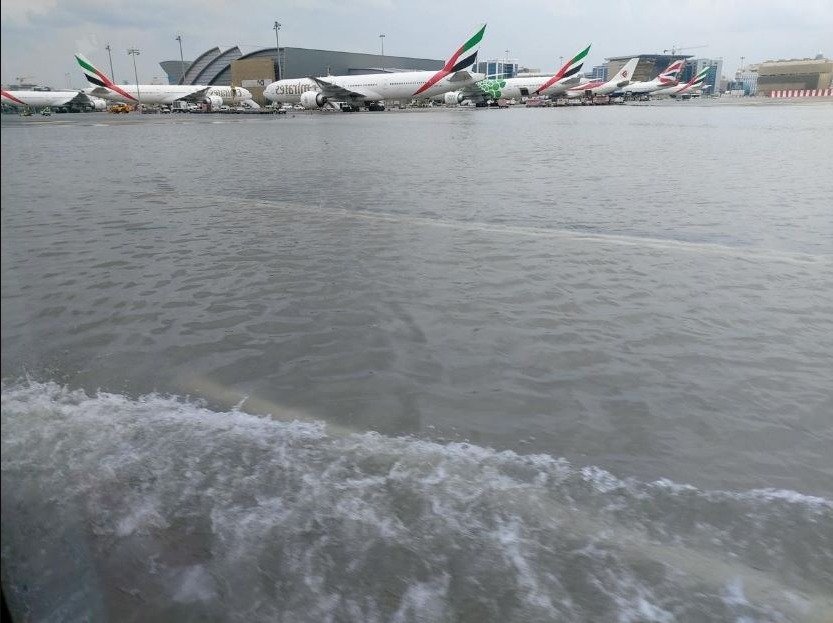Dubai International Airport has swiftly bounced back to full operational capacity just one week after experiencing unprecedented flooding that brought its bustling activity to a standstill. The record-breaking deluge, which saw the desert city inundated with a year’s worth of rain in mere hours, posed significant challenges to the airport’s infrastructure and caused widespread disruptions. This article delves into the aftermath of the floods, the concerted restoration efforts, the economic repercussions, and the lessons learned to bolster future resilience.
Table of Contents
ToggleKey Takeaways
- Dubai International Airport, the world’s busiest for international travel, was severely impacted by record-breaking floods, grounding flights and straining the city’s drainage systems.
- Emergency response teams and airport personnel worked around the clock to manage the crisis, successfully restoring operations within a week.
- The flooding resulted in substantial financial losses for the aviation sector, with Emirates alone cancelling nearly 400 flights.
- The incident has highlighted the need for evaluating and enhancing the airport’s infrastructure to withstand extreme weather events.
- Despite the severity of the floods, Dubai’s swift recovery efforts minimized long-term economic impacts and restored confidence in the region’s disaster preparedness.
The Aftermath of the Deluge: Assessing the Impact on Dubai Airport
Overview of the Flooding Incident
Dubai International Airport faced an unprecedented challenge when a historic weather event led to severe flooding, disrupting operations and infrastructure. The intensity of the storm surpassed any previous records since 1949, highlighting the vulnerability of the region to such natural disasters. The airport, a hub for international travel, was particularly affected, with the deluge impacting various facets of its operations.
The flooding incident caused significant disruptions:
- Overwhelmed drainage systems
- Neighborhoods and highways submerged
- Schools closures extended
- Official damage reports pending
The scale of the flooding was such that it not only affected the airport’s functionality but also posed serious safety concerns for the community at large. The response required was beyond the routine, demanding extraordinary measures to manage the crisis.
While the full extent of the damage is still being assessed, the incident has already been marked by at least one fatality, underscoring the severity of the situation. The community of Mudon experienced flooding up to 1 meter deep, challenging civil defense workers as they endeavored to mitigate the impact.
Challenges in Water Management
The recent flooding in Dubai Airport highlighted significant challenges in water management, particularly in a region unaccustomed to such levels of precipitation. The lack of drainage infrastructure was starkly evident as the airport struggled to cope with the unexpected deluge. The situation was exacerbated by the urban environment, which is typically designed to handle heat and sand, not torrential rain.
- The scale of the task at hand was daunting.
- Urban planning standards were put to the test.
- Resilience measures were found to be lacking.
The deluge speaks to the need for integrated resilience measures in urban planning.
Efforts to manage the water were further complicated by the sheer volume of rainfall, which in some areas of Dubai reached up to 3 feet, overwhelming civil defense officials. This incident has brought to the forefront the importance of sustainability and the momentum it is gaining in the aviation sector, with a pressing need for airports to develop comprehensive plans and initiatives for water management.
Impact on Flight Operations and Passengers
The record-breaking floods at Dubai Airport brought unprecedented disruptions to flight operations, with Dubai’s flagship carrier Emirates and sister airline flydubai having to suspend check-in and transit operations. This left thousands of passengers stranded, as the airport grappled with flooded taxiways that led to widespread flight diversions, delays, and cancellations.
Affected passengers faced long queues and significant uncertainty. Despite the challenges, the airport’s management and airline staff worked tirelessly to accommodate and assist travelers. The commitment to service is evident in the efforts to secure accommodations and other amenities for those affected.
The restoration of full flight schedules marks a significant milestone in the airport’s return to normalcy, reflecting the resilience and dedication of all parties involved.
The following table summarizes the impact on flight operations and passengers:
| Aspect | Details |
|---|---|
| Suspended Operations | Check-in and transit through Dubai International Airport |
| Stranded Passengers | Thousands of travelers affected |
| Flight Disruptions | Diversions, delays, and cancellations |
| Recovery Actions | Accommodation and amenities provided for affected passengers |
Restoration Efforts and Resumption of Services
Emergency Response and Cleanup Operations
In the wake of the unprecedented flooding, Dubai Airport’s emergency response was swift and multifaceted. Cleanup crews worked around the clock, addressing the immediate aftermath and ensuring the safety of stranded passengers and airport personnel. The focus was on water extraction from critical areas, restoring power, and clearing debris to facilitate a return to normal operations.
- Water pumping from runways and taxiways
- Debris removal from airport facilities
- Electrical systems checks and repairs
- Coordination with airlines for rescheduling flights
The concerted efforts of emergency teams and volunteers were instrumental in mitigating the impact of the floods on airport operations. Despite the challenges, the airport was able to resume partial services within days, showcasing the resilience and preparedness of the emergency response systems in place.
The restoration process was not without its difficulties. Sheikh Zayed Road, a vital artery for airport access, saw significant disruptions due to cleanup operations. Meanwhile, the broader region, including Sharjah and Abu Dhabi, continued to grapple with the visible scars left by the storm.
Timeline of Recovery and Service Restoration
The path to restoring full operations at Dubai Airport was marked by a series of critical milestones. The airport’s swift recovery efforts were crucial in mitigating the impact of the floods on global travel. After the unprecedented rainfall, the airport faced a complete halt in operations, with outgoing travelers unable to check in for their flights.
Following the initial response, the airport’s management outlined a clear timeline for recovery. The first significant step was the resumption of flights into Terminal 1, a vital move to alleviate some of the congestion caused by the floods. Shortly after, Emirates, a key player in east-west travel, began allowing local passengers to arrive at Terminal 3, signaling a turn towards operational normalcy.
The airport’s CEO, Paul Griffiths, indicated that the airfield required an additional 24 hours to dry out and return to a schedule resembling its usual efficiency. This period was critical in ensuring safety and reliability as services ramped up.
Despite the challenges, the airport’s coordinated efforts with airlines and emergency services led to a gradual but steady return to full capacity. The table below summarizes the key phases in the recovery process:
| Date | Milestone |
|---|---|
| Day 1-2 | Airport closure and emergency assessment |
| Day 3 | Limited resumption of flights in Terminal 1 |
| Day 4 | Emirates allows local passengers in Terminal 3 |
| Day 5 | Full-scale cleanup and safety checks |
| Day 6 | Test flights and systems checks |
| Day 7 | Resumption of full operations |
Coordination Among Airlines for Operational Normalcy
In the wake of the record-breaking floods, airlines at Dubai Airport have been working tirelessly to coordinate efforts and restore normal operations. The primary focus has been on managing the backlog of passengers affected by the disruptions and ensuring that flight crews and pilots can safely access the airport.
The collaboration between carriers has been pivotal in resuming flights, with Emirates and FlyDubai among the first to announce a return to their regular schedules.
Airlines have also been proactive in communicating with stranded passengers, providing updates on flight statuses and arranging accommodations where necessary. The Chief Operating Officer of Dubai Airports, Majed Al Joker, projected a swift recovery, anticipating a return to 60-70% capacity shortly, with full operational capacity expected within a day.
The table below outlines the recovery progress as reported by major airlines operating in Dubai Airport:
| Airline | Status Update | % of Recovery |
|---|---|---|
| Emirates | Resumed normal operations | 100% |
| FlyDubai | Resumed normal operations | 100% |
| Other Carriers | Gradual resumption | 60-70% |
This concerted effort underscores the resilience of the aviation community in Dubai and sets a precedent for future emergency response coordination.
Economic Implications of the Record-Breaking Floods
Financial Toll on the Aviation Sector
The recent floods have placed a significant financial burden on the aviation sector, particularly affecting Dubai International Airport and its primary carrier, Emirates. The disruption of operations has led to substantial revenue losses and increased operational costs.
The immediate financial impact is evident in the number of flights canceled or delayed, and the additional resources deployed for emergency response and recovery. The table below provides a snapshot of the financial repercussions:
| Aspect | Detail |
|---|---|
| Canceled Flights | Over 500 flights canceled |
| Delayed Flights | More than 1,000 flights delayed |
| Emergency Response Costs | Estimated in millions of dollars |
| Passenger Compensation | Refunds and accommodations for travelers |
The ripple effect of these disruptions extends beyond the airport, affecting the broader network of businesses and services that rely on a fully functional aviation hub.
In the aftermath, airlines are grappling with the logistics of rebooking passengers and managing the backlog of flights, further straining their financial reserves. The full extent of the economic damage will likely unfold in the coming weeks as the sector begins to reconcile the costs associated with the floods.
Projected Losses and Recovery Costs
In the wake of the record-breaking floods, Dubai Airport faces a daunting financial challenge. The unprecedented deluge, which brought two years’ worth of rain in just 24 hours, has necessitated a massive expenditure on recovery efforts. The airport, a critical hub for international travel, incurred significant losses due to suspended flight operations and infrastructure damage.
The financial repercussions extend beyond immediate repair costs, encompassing revenue losses from halted flights and additional operational disruptions.
A preliminary assessment outlines the projected costs associated with the disaster:
- Immediate infrastructure repair and water removal
- Compensation for affected passengers and airlines
- Loss of revenue during the period of inactivity
- Long-term investments in flood prevention and management systems
These projections are subject to change as the full extent of the damage becomes clearer and recovery operations continue.
Long-Term Economic Impact on the Region
The record-breaking floods in Dubai have not only caused immediate disruptions but also pose a significant threat to the long-term economic stability of the region. The aftermath of such disasters often accelerates the widening of economic disparity, particularly affecting the most vulnerable populations.
- Accelerated widening of economic disparity due to recurrent floods
- Hindrance to sustainable development
- Amplification of poverty traps under climate change
The scale of this task is more daunting than it appears, involving substantial changes to the urban environment in a region historically characterized by heat and sand.
The economic implications extend beyond the aviation sector, potentially affecting various industries such as tourism, retail, and construction. Recovery efforts must therefore be comprehensive, addressing not only immediate damages but also the underlying vulnerabilities that these floods have exposed.
Infrastructure Resilience and Future Preparedness
Evaluating the Adequacy of Current Infrastructure
In the wake of the unprecedented flooding, questions have been raised about the adequacy of Dubai’s infrastructure to handle such extreme weather events. The recent deluge has highlighted the need for a comprehensive assessment of the airport’s ability to withstand and manage severe weather conditions.
The airport’s drainage systems, designed for a region accustomed to heat and minimal rainfall, were overwhelmed by the sheer volume of water. This has prompted a critical review of the existing water management and drainage infrastructure. The lack of adequate drainage facilities has been identified as a key issue, with experts suggesting that the current systems are insufficient for the changing climate patterns.
The challenge now lies in adapting the urban environment of a region that has historically dealt with heat and sand to the new realities of climate variability.
Sheikh Mohammed bin Zayed Al Nahyan’s commitment to quickly assess and improve the UAE’s infrastructure is a step towards ensuring that such disruptions are minimized in the future. The resilience measures integrated into urban planning will be crucial in determining how well the region can cope with similar events moving forward.
Investments in Flood Prevention and Management
In the wake of the unprecedented flooding, Dubai’s authorities have recognized the urgent need for enhanced flood prevention and management strategies. Investments in infrastructure upgrades and innovative technologies are now pivotal to safeguard against future deluges.
Following the recent crisis, a comprehensive review of the existing drainage systems and water management protocols is underway. This review aims to identify critical vulnerabilities and implement necessary improvements. The table below outlines the proposed investments and their objectives:
| Investment Area | Objective |
|---|---|
| Drainage System Overhaul | Enhance capacity to manage heavy rainfall |
| Advanced Weather Forecasting Tools | Improve early warning systems |
| Emergency Response Training | Strengthen rapid response capabilities |
In addition to infrastructural changes, there is a push for community-level initiatives that promote resilience. These include educational programs to prepare citizens for flood-related emergencies and the development of local response teams.
The recent flooding event has been a wake-up call, prompting a shift in priorities towards more robust flood defense mechanisms. The goal is to not only recover from the current impact but to emerge stronger and better prepared for any future challenges.
Strategies for Enhancing Airport Resilience
In the wake of the recent floods, Dubai Airport has initiated a comprehensive review of its resilience strategies to better withstand such events in the future. The focus is on future-proofing the airport’s infrastructure against a changing climate, which includes identifying vulnerabilities and implementing adaptation measures.
The airport’s resilience plan is being updated to embrace sustainable practices that mitigate the risks posed by climate change.
Key initiatives include:
- Upgrading drainage systems to handle extreme weather events
- Enhancing the capacity of emergency response teams
- Investing in advanced weather monitoring and forecasting technologies
- Developing contingency plans for rapid recovery post-disaster
These measures aim to ensure that the airport remains a reliable hub for international travel, even in the face of increasingly unpredictable weather patterns.
Conclusion
In the wake of the unprecedented flooding that brought Dubai International Airport to a standstill, the resilience and efficiency of the airport’s response have been commendable. Within a week, full operations have resumed, marking a swift recovery from the record-breaking weather event. This quick turnaround not only reflects the robust infrastructure and preparedness of the airport but also the dedication of its staff and the cooperation of airlines and passengers alike. As the airport moves forward, assessments of the damages and the financial impact will be crucial in reinforcing the city’s defenses against such rare but potentially disruptive weather phenomena. The return to normalcy at the world’s busiest airport for international travel is a testament to Dubai’s ability to bounce back from adversity and maintain its status as a global aviation hub.
Frequently Asked Questions
How long was Dubai International Airport affected by the floods?
Dubai International Airport experienced disruptions for several days due to unprecedented flooding, with operations significantly impacted until the airport resumed full operations a week after the floods.
What caused the record-breaking floods in Dubai?
The record-breaking floods were caused by unusually heavy rainfall that overwhelmed the city's infrastructure and drainage systems, leading to significant flooding including at the airport.
How many flights were cancelled or delayed due to the flooding?
Emirates alone cancelled nearly 400 flights and many more were delayed as a result of the storm, with additional cancellations and delays affecting other airlines operating at the airport.
What measures are being taken to prevent future flooding at the airport?
Authorities are assessing the damages and the adequacy of current infrastructure, with plans to invest in flood prevention, management strategies, and enhancements to airport resilience.
What was the economic impact of the flooding on Dubai's aviation sector?
The exact economic impact is being assessed, but the flooding caused significant financial toll due to flight cancellations, delays, and the cost of cleanup and recovery efforts.
How did the airport manage to resume full operations within a week?
The resumption of full operations was made possible through coordinated emergency response, extensive cleanup operations, and collaborative efforts among airlines and airport personnel to restore services efficiently.









